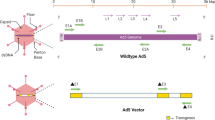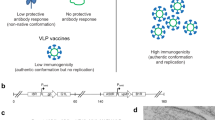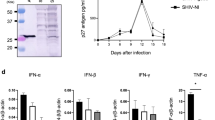Abstract
A global vaccination strategy must take into account production and delivery costs as well as efficacy and safety. A heat-stable, polyvalent vaccine that requires only one inoculation and induces a high level of humoral and cellular immunity against several diseases is therefore desirable. A new approach is to use live microorganisms such as mycobacteria1, enteric bacteria2,3, adenoviruses4, herpes viruses5,6 and poxviruses7 as vaccine vectors. A potential limitation of live polyvalent vaccines, however, is existing immunity within the target population not only to the vector, but to any of the expressed antigens. This could restrict replication of the vector, curtail expression of antigens, and reduce the total immune response to the vaccine. Recently acquired immunity to vaccinia virus can severely limit the efficacy of a live recombinant vaccinia-based vaccine8, so a strategy involving closely spaced inoculations with the same vector expressing different antigens may present difficulties. We have constructed a recombinant vaccinia virus that expresses surface proteins from two diverse pathogens, influenza A virus haemagglutinin and herpes simplex virus type 1 (HSV-1) glycoprotein D. Mice that had recently recovered from infection with either HSV-1 or influenza A virus could still be effectively immunized with the double recombinant.
This is a preview of subscription content, access via your institution
Access options
Subscribe to this journal
Receive 51 print issues and online access
$199.00 per year
only $3.90 per issue
Buy this article
- Purchase on Springer Link
- Instant access to full article PDF
Prices may be subject to local taxes which are calculated during checkout
Similar content being viewed by others
References
Jacobs, W. R., Tuckman, M. & Bloom, B. R. Nature 327, 532–535 (1987).
Clements, J. D. & El-Morshidy, S. Infect. Immunity 46, 564–569 (1984).
Baron, L. S. et al. Infect. Immunity 55, 2797–2801 (1987).
Davis, A. R. et al. Proc. natn. Acad. Sci. U.S.A. 82, 7560–7564 (1985).
Shih, M.-F., Arsenakis, M., Tiollais, P. & Roizman, B. Proc. natn. Acad. Sci. U.S.A. 81, 5867–5870 (1984).
Lowe, R. S. et al. Proc. natn. Acad. Sci. U.S.A. 84, 3896–3900 (1987).
Moss, B. & Flexner, C. A. Rev. Immun. 5, 305–324 (1987).
Rooney, J., Wohlenberg, C., Cremer, K., Moss, B. & Notkins, A. L. J. Virol 62, 1530–1534 (1988).
Panicali, D., Davis, S. W., Weinberg, R. L. & Paoletti, E. Proc. natn. Acad. Sci. U.S.A. 80, 5364–5368 (1983).
Smith, G. L., Murphy, B. R. & Moss, B. Proc. natn. Acad. Sci. U.S.A. 80, 7155–7159 (1983).
Andrew, M. E., Coupar, B. E. H., Ada, G. L. & Boyle, D. B. Microbial Pathogenesis 1, 443–452 (1986).
Paoletti, E., Lipinskas, B. R., Samsonoff, C., Mercer, S. & Panicali, D. Proc. natn. Acad. Sci U.S.A. 81, 193–197 (1984).
Cremer, K. J., Mackett, M., Wohlenberg, C., Notkins, A. L. & Moss, B. Science 228, 737–740 (1985).
Perkus, M. E., Piccini, A., Lipinskas, B. R. & Paoletti, E. Science 229, 981–984 (1985).
Bennink, J. R., Yewdell, J. W., Smith, G. L. & Moss, B. J. Virol. 57, 786–791 (1986).
Chakrabarti, S., Brechling, K. & Moss, B. Molec. cell Biol. 5, 3403–3409 (1985).
Murphy, B. R. et al. J. clin. Microbiol. 13, 554–560 (1981).
McKendall, R. & Woo, W. J. gen. Virol. 69, 847–857 (1988).
Rector, J., Lausch, R. & Oakes, J. Infect. Immunity 55, 2797–2801 (1987).
Fenner, F. in Virology (eds Fields, B. N. et al.) 661–684 (Raven, New York, 1985).
Flexner, C., Hugin, A. & Moss, B. Nature 330, 259–262 (1987).
Mackett, M., Smith, G. L. & Moss, B. in DNA Cloning Vol. 2 (ed. Glover, D. M.) 191–212 (1RL, Oxford, 1985).
Massicot, J. G. et al. Virology 101, 242–249 (1980).
Nerurkar, L. S. et al. J. clin. Microbiol. 20, 109–114 (1984).
Buller, R. M. L., Bhatt, P. N. & Wallace, G. D. J. clin. Microbiol. 18, 1220–1225 (1983).
Author information
Authors and Affiliations
Rights and permissions
About this article
Cite this article
Flexner, C., Murphy, B., Rooney, J. et al. Successful vaccination with a polyvalent live vector despite existing immunity to an expressed antigen. Nature 335, 259–262 (1988). https://doi.org/10.1038/335259a0
Received:
Accepted:
Issue Date:
DOI: https://doi.org/10.1038/335259a0
This article is cited by
-
Raccoon poxvirus rabies virus glycoprotein recombinant vaccine in sheep
Archives of Virology (1993)
-
The live vector approach—viruses
World Journal of Microbiology and Biotechnology (1991)
Comments
By submitting a comment you agree to abide by our Terms and Community Guidelines. If you find something abusive or that does not comply with our terms or guidelines please flag it as inappropriate.



